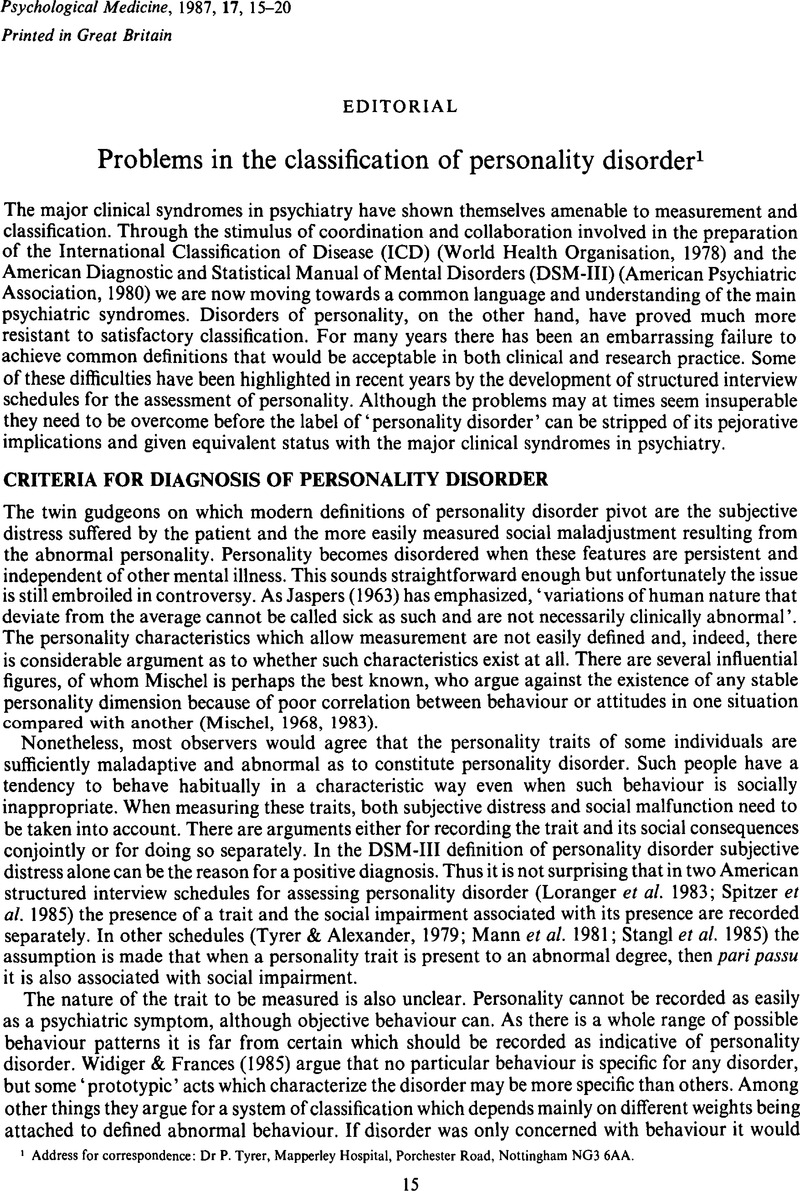Crossref Citations
This article has been cited by the following publications. This list is generated based on data provided by Crossref.
Links, Paul S.
1988.
Symposium: Borderline Personality Disorder.
The Canadian Journal of Psychiatry,
Vol. 33,
Issue. 5,
p.
335.
Taylor, Pamela J.
1988.
Forensic Psychiatry.
British Journal of Psychiatry,
Vol. 153,
Issue. 2,
p.
271.
Wolff, Sula
1989.
Early Influences Shaping The Individual.
p.
283.
Hill, J.
Harrington, R.
Fudge, H.
Rutter, M.
and
Pickles, A.
1989.
Adult Personality Functioning Assessment (APFA).
British Journal of Psychiatry,
Vol. 155,
Issue. 1,
p.
24.
Mavissakalian, Matig
1990.
The Relationship Between Panic Disorder/Agoraphobia and Personality Disorders.
Psychiatric Clinics of North America,
Vol. 13,
Issue. 4,
p.
661.
Mavissakalian, Matig
Hamann, Mary Sue
and
Jones, Bruce
1990.
A comparison of DSM-III personality disorders in panic/agoraphobia and obsessive-compulsive disorder.
Comprehensive Psychiatry,
Vol. 31,
Issue. 3,
p.
238.
Overholser, James
1990.
Retest Reliability of the Million Clinical Multiaxial Inventory.
Journal of Personality Assessment,
Vol. 55,
Issue. 1,
p.
202.
Denis, Jean-Francois
1990.
Le Problème des Troubles de la Personnalité en Psychiatrie.
The Canadian Journal of Psychiatry,
Vol. 35,
Issue. 3,
p.
208.
Peralta, V.
Cuesta, M. J.
and
de Leon, J.
1991.
Premorbid personality and positive and negative symptoms in schizophrenia.
Acta Psychiatrica Scandinavica,
Vol. 84,
Issue. 4,
p.
336.
Fabrega, Horacio
Ulrich, Richard
Pilkonis, Paul
and
Mezzich, Juan
1991.
On the homogeneity of personality disorder clusters.
Comprehensive Psychiatry,
Vol. 32,
Issue. 5,
p.
373.
Zimmerman, Mark
Pfohl, Bruce
Coryell, William H.
Corenthal, Caryn
and
Stangl, Dalene
1991.
Major depression and personality disorder.
Journal of Affective Disorders,
Vol. 22,
Issue. 4,
p.
199.
Wolff, Sula
1991.
‘Schizoid’ Personality in Childhood and Adult Life III: The Childhood Picture.
British Journal of Psychiatry,
Vol. 159,
Issue. 5,
p.
629.
Overholser, James C.
1992.
Interpersonal dependency and social loss.
Personality and Individual Differences,
Vol. 13,
Issue. 1,
p.
17.
Mavissakalian, Matig R.
Hamann, Mary Sue
Haidar, Said Abou
and
de Groot, Christopher M.
1993.
DSM-III personality disorders in generalized anxiety, panic/agoraphobia, and obsessive-compulsive disorders.
Comprehensive Psychiatry,
Vol. 34,
Issue. 4,
p.
243.
Overholser, James C.
1994.
The personality disorders: A review and critique of contemporary assessment strategies.
Journal of Contemporary Psychotherapy,
Vol. 24,
Issue. 4,
p.
223.
Smith, Jeanette
and
Hucker, Stephen
1994.
Schizophrenia and Substance Abuse.
British Journal of Psychiatry,
Vol. 165,
Issue. 1,
p.
13.
Kaplan, Carole Ann
and
Kolvin, Israel
1994.
The assessment of personality in young adulthood: Data on a normative sample.
European Child & Adolescent Psychiatry,
Vol. 3,
Issue. 1,
p.
37.
Smith, Thomas E.
Shea, M. Tracie
Schooler, Nina R.
Levin, Harry
Deutsch, Andrea
and
Grabstein, Eric
1995.
Personality Traits in Schizophrenia.
Psychiatry,
Vol. 58,
Issue. 2,
p.
99.
Hill, J.
Fudge, H.
Harrington, R.
Pickles, A.
and
Rutter, M.
1995.
The Adult Personality Functioning Assessment (APFA): factors influencing agreement between subject and informant.
Psychological Medicine,
Vol. 25,
Issue. 2,
p.
263.
Rees, Anne
Hardy, Gillian E
and
Barkham, Michael
1997.
Covariance in the measurement of depression/anxiety and three Cluster C personality disorders (avoidant, dependent, obsessive-compulsive).
Journal of Affective Disorders,
Vol. 45,
Issue. 3,
p.
143.


